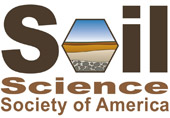Drivers of Soil Microbial Community Composition and Diversity.
Drivers of Soil Microbial Community Composition and Diversity.
Poster Number 4
See more from this Division: PosterSee more from this Session: Biodiversity and Ecological Sustainability
Saturday, March 8, 2014
Grand Sheraton, Magnolia Foyer
[Rationale] Soil microorganisms provide the foundation for many ecosystem services essential to agricultural production systems, including soil organic matter (SOM) formation and accumulation. Agricultural management practices, like tillage and cover cropping, alter soil attributes, and thus, the soil microbial environment and its microbial communities. Understanding the drivers of soil microbial community structure is key to the development of DNA fingerprinting as a soil quality indicator and the identification of functional links between microbial community structure and ecosystem services.
[Objective/Hypotheses] The objective of this study is to elucidate the relative importance of factors in structuring soil bacterial/archaeal communities within winegrape vineyards in the Napa Valley American Viticultural Area (AVA) at the landscape scale. We hypothesized that soil attributes related to resource location and availability (e.g. carbon and nitrogen contents in different size-fractions, porosity and soil water content) that are strongly impacted by management practices (i.e. tillage and cover-cropping) drive soil microbial community structure. Alternatively, soil microbial communities may be structured along gradients in other soil physicochemical properties, such as pH, soil texture, or other properties inherited from the parent material.
[Methods] The Napa Valley AVA includes 225,300 acres of land, known for its diversity of mesoclimates and topography, consisting of mountains, hills, and many dividing valleys. About one fifth of the land area is planted in vineyards. Nineteen vineyard plots were selected, including sites in 8 of the 16 sub-appellations of the Napa Valley AVA. Collected soils include 4 great groups (Haploxeralfs, Haploxerolls, Haploxerults, Xerofluvents) of various textures (including loam, sandy loam, silt loam, and sandy clay loam, with a range in gravel content from none to extremely gravelly) with total nitrogen contents from 1 to 5 g N per kg soil and total carbon contents of 11 to 61 g C per kg soil. Management history was acquired through grower interviews. Soil microbial communities were assessed using 16S rDNA sequences, processed using the QIIME pipeline. Principal coordinates analysis (PCoA) was applied to the phylogenetic distance matrix produced from the UniFrac metric. The relationships of soil inorganic and organic properties (pH, texture, total carbon, total nitrogen, dissolved organic carbon, potentially mineralizable nitrogen, and total organic nitrogen and total organic carbon from the differently-sized soil organic fractions), environmental attributes (topography, precipitation, temperature), and management practices (tillage and cover crop type) with the bacterial/archaeal community composition and diversity are analyzed. These relationships will be assessed using adonis non-parametric multivariate analysis of variance.
[Results] Based on PCoA and a BEST, using the UniFrac distance matrix, preliminary results suggest that pH (5.60-7.52) is the dominant gradient underlying the bacterial/archaeal community structure. Preliminary PCoA also shows that communities separate with tillage, soil particle size class, cover crop type, and agricultural method (conventional, organic, or biodynamic). Spatial effects also appear to play a role, while relationships with carbon and nitrogen pools are weaker. Further assessments are forthcoming.
[Conclusions/Contribution] This work provides insight into relationships of soil microbial community structure with SOM, the environment, and agricultural management practices. This knowledge serves as a foundation to facilitate (i) the development of a DNA-based soil quality assessment and (ii) a greater understanding of the links between soil microbial community structure and soil ecosystem services that are key to the sustainable productivity of perennial agricultural systems.
See more from this Division: PosterSee more from this Session: Biodiversity and Ecological Sustainability
